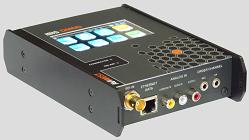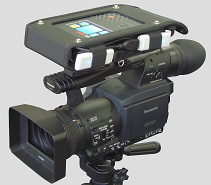Portable Cellular/Wi-Fi Video Broadcast Unit Review: IBIS DMNG
What is it?
France-based AVIWEST's IBIS DMNG is a portable SDI or composite video wireless link that uses Wi-Fi or cellular technology to transmit your live or archived video back to a remote server on the internet, which in turn presents the video as SDI or composite video.
When Would I Use It?
If you were a sports or news journalist wanting to send high quality images back from an outside the studio to your broadcast center, or if you needed an ad-hoc video connection from a location with no fiber or telecom access and you wanted more flexibility than a satellite link (perhaps where there is no line of sight, or no time to set up your satellite link). Incidentally this type of link is called generically -"contribution feed"-just in case you see me use this term below).

Sounds Like Broadcast Kit-Why is it in StreamingMedia?
1) It uses IP Streaming technology to work (more on that in a minute)
2) Many webcasters and live streaming engineers will see this as a useful part of their tool kit
How Does it Compare to StreamBox, Quicklink, and LiveU?
While each has strengths, this is a newer device, and benefits from being the "latest" in a series of this genre of products. Rather than break this technology into the streaming sector with too much accolade I am arranging to conduct a proper benchmark of each of these products as a separate feature later this year. Needless to say, I have been very impressed by this product in its own right.
Background
I used VSAT technology for contribution feeds for the best part of a decade, particularly when we wanted a live feed from an event for just 2 hours. It relied on having a large van with a satellite link on the roof, and a good hour or so on site in advance to align the dish. The service fees varied with the bandwidth you needed, but in essence it was akin to a portable leased line. While it worked in general, there was little resilience in the system and so a there was a high risk that factors such as rain-fade, lack of line of sight, operator or hub issues, and so on could cause problems that rendered the entire event a failure. For a long time, though, it was the only option for sending 512Kbps images live out on the internet without calling out for a full-blown TV production team.
The commonly available cell phone networks, which traditionally only supported very low bitrates and with no guaranteed QoS, were always of interest to webcasters. It has seemed for a long time that the ubiquity of IP via cellular would eventually emerge to become a contribution feed technology. Here in the UK where I'm based, for instance, most cell network operators put an E1 into the base of the cell mast (this is a broad rule, and varies considerably when you get into metro areas). An E1 gives the operator 2Mbps to share out over all the phones that may use the cell. If a webcaster turns up and saturates that entire 2Mbps (and if they conjecturally could take a priority over all the other wireless 3G users in the area) then no one else would be able to use that cell for that period of time. No cell network operator will do that.
Equally to provision every cell with an extra E1 "just in case" a webcaster wants to use it requires a whole lot more regular use and justification/demand for the service than exists.
So how does a webcaster get to stream a high bitrate contribution feed back to their service center?
In the past few years, 3G multiplexers have changed everything. A 3G multiplexer has services connected from typically four network operators. It "bonds" these together in the field and presents them as a single consolidated service to the device in the operator's hand. This means that the operator has access to, say, four 300Kbps sections of the four operators, but added together this appears to be 1200Kbps.
Now since he is contending with many other users on the cell network it is important to note that this 300Kbps may vary from minute to minute. This is not a QoS guaranteed service-it is a "best effort" service. Since these access circuits are "net neutral" the contention is a bit of a bun fight, and so multiplexer-based systems in this context have to be able to adapt to variation on the fly. And that is exactly what they do. As the bandwidth drops, the encoding quality is reduced: The stream becomes more pixelated and lower resolution, but if the technology works properly there is a continuity of audio and regular enough motion in the image that the viewer's brain can actually compensate until the quality recovers.
For this reason these technologies are suited to "extreme" cases where there are no alternative connections such as leased lines, fibers, and satellites that could provide a better QoS.
But as audiences have acclimatised to lower quality video through the proliferation of webcams, phone cams, YouTube, and so on, even broadcast media commonly makes extensive use of low bitrate images: The key is that if this is the only way to capture the content that everyone wants to see then the priority is to get the content whatever the quality.
Back to the IBIS DMNG v2
I managed to catch up with Richard Pattison and his colleagues at the Sky News Technology team, who have been testing a variety of these products including the DMNG. They have been testing for about a month, although they missed the recent student riots in London which would have provided a great opportunity for them to "test it in anger" since that is exactly the scenario where this type of technology comes into its own. In that cynical way that we in the industry sometimes wait for a "good disaster" to happen I have asked Richard to let me know how it fares when they finally to get a change to use it "in anger."
The first thing that stands out is the compact size of this unit. Being about the same size as a box of chocolates, it initially begs the question "where's the rest of it?" This thing is small-less than 2 lbs (1 kg) in weight, a footprint about the size of a business letter, and a little more than an inch deep.
Having something this small that functionally (in many ways) replaces an entire outside broadcast truck is, in my little geeky world, absolutely insane. I can't emphasise this enough.
If you had told me in 1998 (when I started looking at delivering my first IP VSAT live streams) that ten years later a van, dish, alignment tools, and video encoders would be replaced by a single unit you could fit in your hand, I would have been impressed. Actually holding that box a dozen years later and seeing it work just as well was simply mind-blowing.

The rugged, field-ready unit has SDI and composite interfaces that allow you to connect the camera directly. Being so small and light, the cameraman can either wear it on his belt or can even clip it onto their flash-shoe horn on their camera. It runs for an hour of live 2Mbps off its own battery, and can also use standard camera batteries, so no need to run out of power when out and about.
Once it is configured (usually at home base) then it's a simple "power on and wait" process. It takes a minute or two to boot up and then, very simply, at the remote end (where ever that server may be on the internet) the SDI output presents the picture the camera is producing.
Interestingly the server can receive four feeds at once and (it has a Windows 7-based PC at its heart) you can then simply click on which feed you want to output to the SDI for seamless switching. I am informed that the next version will have four SDI out cards so all four signals can be sent to production in parallel.
Latency is a question that those experienced will ask about: Well, on the DMNG its switchable: We tested the 5 seconds setting and also the 3 seconds setting. Amazingly, it did exactly what it said on the tin: 5 seconds or 3 seconds latency. At 3 seconds we found that the artifacting and pixilation was more common-particularly if there was a significant change in the signal strength and often resulting in a 3s freeze of video, but the audio trundled along just fine. (Don't believe me? Check out the video of our testing below.)
A really nice feature was the talk back feature. Often talk back to the studio to cue the presenter up with the live bulletin has required nothing more complex than a cell phone. However during a report it's hard for the reporter to look professional with a cell phone pressed to her ear. The DMNG allows the production communications to be looped in so that the presenter can, through the same link, talk to the studio. Even better, there is a tally light connection too so that its clear when the camera signal is live. No more "Oh f**k, are we live??" going out on air.
And do you know what? From the user point of view, that's it. Yes, there is a wide range of configuration if you want to manually tweak the H.264-based codec setup, such as the output size and format. And you can change and manage the cell phone dongles either from the unit or from the server. And so on. But this is not something you want to tinker with in the field unless you are stuck; it's best set up once and then just left to charge and use with a single press of the power button.
That's what I like about the IBIS DMNG. It's a step away from being built into the camera, if you are asking me. I can see a next generation taking advantage of adaptive bitrate, moving away from the inferior variable bitrate models currently in use, since ABR requires too much CPU to be condensed into this form factor. Once that is completed, I can then see this technology being miniaturised to the point it comes as standard on the smart phone (perhaps that's why Skype just acquired Qik?).
But for the moment, the DMNG is a professional solution to a problem that has troubled the professionals for year: ultra-portable, ultra-fast, ad-hoc video contribution.
Expect to see footage both on TV and online that uses this GREAT example of intelligent streaming media innovation on a screen near you very soon.
Related Articles
Yet another entrant in the "cellular multiplexer" field, the Teradek Bond offers reliable, good-quality streaming over cellular networks for a reasonable price
09 Feb 2012
Companies and Suppliers Mentioned